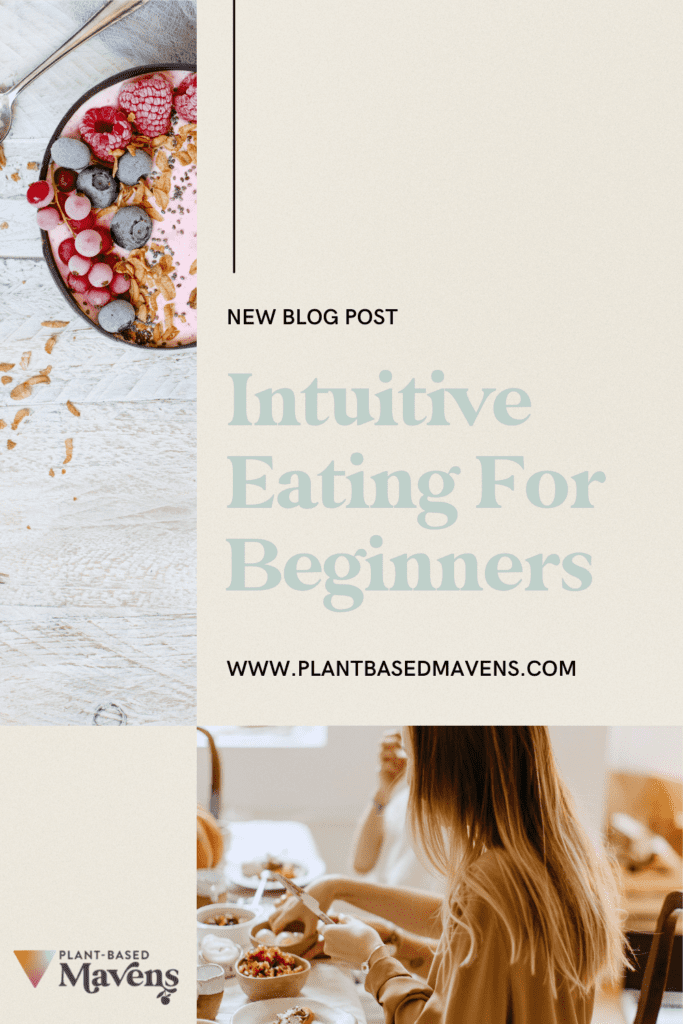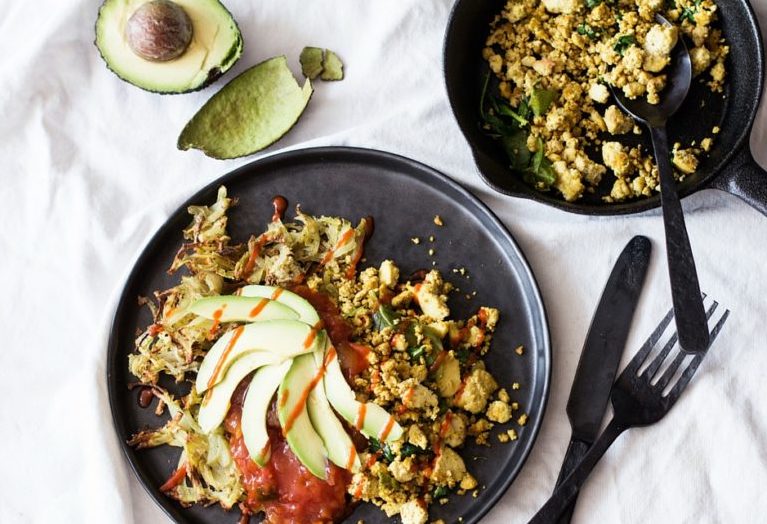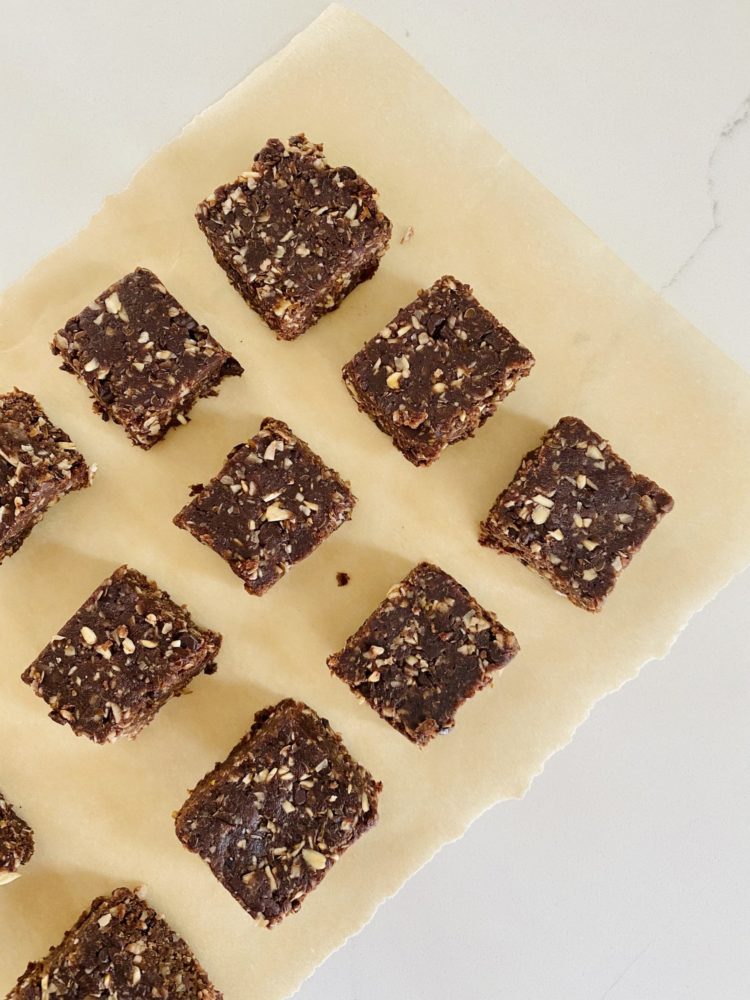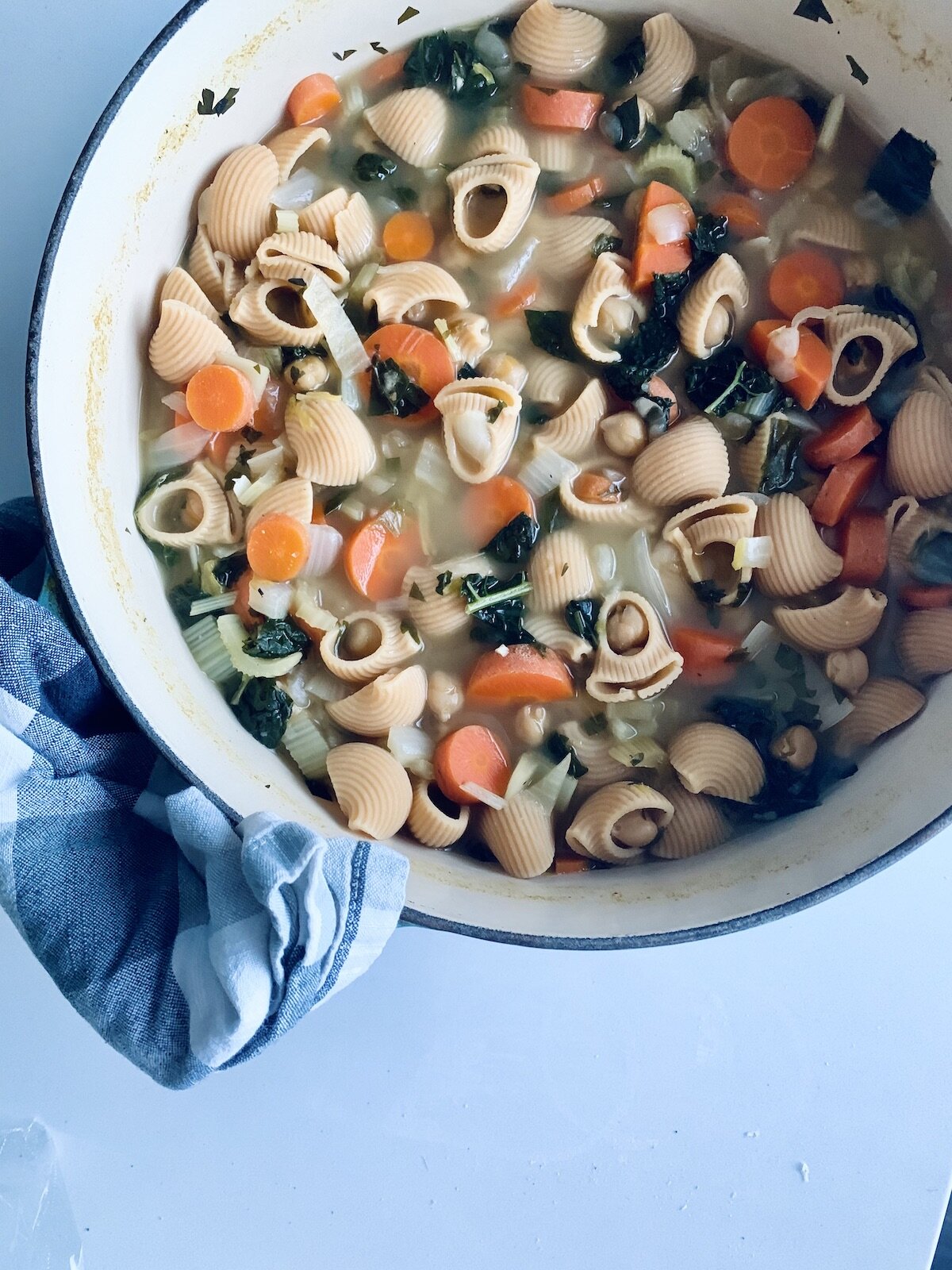If you pay any attention to the wellness world, then you’ve probably heard people talk about intuitive eating. But what is intuitive eating? And should you try it? As a Certified Intuitive Eating Counselor, I can tell you that this fresh approach to nutrition is worth the hype. I can also tell you that the wellness world often misrepresents intuitive eating. Let’s dive in to what intuitive eating actually means, why you should try it, and how to get started on your intuitive eating journey.

Have you ever seen an advertisement or someone else’s social media post that triggered a negative thought about yourself? Suddenly, you feel bad for eating that toast because a fit influencer said that carbs are evil. Or you feel ashamed that your postpartum body doesn’t look like the thin celebrity’s on the the magazine cover. It’s nearly impossible to escape the unrealistic expectations of these overt and covert messages about our bodies, skin, hair, and food choices that we see in diet books, fad diet marketing, and other sources that promote diet mentality. Everywhere we turn, a $200+ billion diet industry inundates us with messages. They tell us how we don’t measure up and promise to make us thinner, prettier, healthier, and happier. (If you’re feeling stuck in a cycle of dieting, read my post about why diets don’t work and how to break free from constant dieting)
Intuitive eating (IE) is the antidote to these dangerous messages, collectively known as diet culture. IE is a research-backed self-care eating framework framework that teaches you how to reconnect with your body’s innate wisdom. It teaches you how to shut out diet culture, tune in to your wise body, and make health decisions from a place of self-care.
Benefits of IE include: higher self-esteem and body image; lower rate of depression, anxiety, emotional eating, and disordered eating; and higher quality of life.
Does intuitive eating work?
Intuitive eating is a non-diet approach to changing eating behaviors that focuses on tuning into your body’s internal signals of hunger, fullness, and satisfaction. When I tell people about the intuitive eating approach, they often think it sounds too good to be true! So, does it actually work?
Many people who have adopted intuitive eating have reported positive outcomes, including health outcomes. IE is associated with better blood sugar and A1c levels, lower LDL cholesterol and higher HDL cholesterol numbers, and lower blood pressure. There’s also correlation between eating intuitively and lower body mass index and healthy weight.
Research studies have shown that intuitive eating may lead to improved mental health, reduced emotional eating, and better self-esteem. Studies have also shown improved body image and improvements in body appreciation and body satisfaction, body trust, body cue awareness, and well-being when IE principles are practiced. Intuitive eaters tend to have greater enjoyment of eating, lower rates of emotional eating, and higher levels of self-compassion. It has also been associated with lower levels of disordered eating behaviors and a decrease in binge eating episodes, as well as overall healthy eating patterns.
IE can help you break free from restrictive diets, chronic dieting, militant exercise regimens, and other strict rules around health and appearance. The practices of IE help you tune into hunger and satiety cues, prioritize your satisfaction, and develop a healthier mindset towards food.
IE can be an effective approach to improve your relationship with food and your body. While it is not a quick fix for weight loss, it can lead to long-term positive changes in eating behaviors and overall well-being. Give it a try and see if it works for you!
How is intuitive eating different from mindful eating?
Intuitive eating and mindful eating are two approaches to food and eating that focus on developing healthy relationships with food and listening to your body’s cues. While both practices incorporate elements of awareness and intention, they differ in their overall focus and goals.
Intuitive eating is a weight-inclusive, self-care eating framework that encourages individuals to use their instincts and physical and mental cues to decide when and how much food to eat. It emphasizes listening to your body’s hunger and fullness signals, as well as honoring your cravings and preferences without judgment. Intuitive eating is not a diet or a set of rules, but rather a flexible and individualized approach to nourishing your body and enjoying food.
On the other hand, mindful eating is about practicing awareness and intention while eating. It involves paying attention to the sensory experience of eating, such as the taste, texture, and smell of food, as well as being present in the moment without distractions. Mindful eating can help individuals slow down and savor their food, leading to a greater appreciation for the eating experience and potentially reducing overeating or emotional eating.
While intuitive eating incorporates elements of mindfulness, such as being present and aware of your body’s cues, it also includes principles around exercise and body respect. Intuitive eating is a more comprehensive approach to food and eating that focuses on self-care and listening to your body, while mindful eating is more about being present and intentional in the act of eating.
Both intuitive eating and mindful eating can be valuable tools for developing a healthy relationship with food. They can be used together to complement each other and help support long-term health. By incorporating elements of both practices into your daily routine, you can learn to trust your body’s signals, enjoy your food more fully, and cultivate a positive and sustainable approach to eating.
Why I became an intuitive eating dietitian
A brief history: two registered dietitians, Elyse Resch and Evelyn Tribole, developed IE in the early 1990’s. Exhausted from deploying all the traditional diet-centric methods of nutrition (meal plans, calorie counting, etc.) and not seeing any real progress or healing in their clients, they knew there had to be a better way. And so, IE was born. Check out the Intuitive Eating book, workbook, and card deck.
IE has completely transformed the way I think about nutrition and how I work with clients. It has restored my ability to truly help people form a sustainable, healthy relationship with food. Here are my five favorite things you will learn on your IE journey.
(If you are ready to dive deeper now, grab your seat in my free Intuitive Eating Training)
10 Principles of Intuitive Eating
1. Reject the diet mentality
We are like fish swimming in the sea of our culture, unable to see that the “water” we are swimming in (cultural norms around controlling our weight and appearance) is toxic to our bodies, minds, and spirits.
When you bring awareness to dieting mentality, you notice it everywhere – airbrushed bodies in magazines, social media filters, diet plans, and friends criticizing their bodies to each other.
This principle is about noticing these toxic messages, acknowledging how they’ve infiltrated your thoughts and behaviors, and beginning to detox them from your life.
2. Honor your hunger
Feeling physical hunger is a normal, healthy signal that tells you when your body needs nourishment. Yet, many women are in the habit of rejecting their hunger cues. You might ignore or suppress hunger cues for many reasons – as a way to manipulate weight, life stress, or disconnection from your body’s messages.
Ignoring your physical hunger cues sends you into an urgent state of “primal hunger” that often results in overeating. Ignoring your hunger is like holding your breath, and primal hunger is like inevitably needing to gasp for air.
Noticing your hunger levels and honoring it by eating is the first step toward learning to tune into your body signals and trust yourself with food.
3. Make peace with food
Principle 3 is about giving yourself unconditional permission to eat, especially the foods that you’ve deemed “off limits”. This principle sounds crazy to a lot of people. Unconditional permission to eat ice cream – is that healthy? When you restrict or forbid a food, your natural sense of deprivation kicks in. You experience obsessive thoughts and begin to build up a craving for the food. Research shows that more off limits we make a food, the more we want it.
By making peace with food, you set yourself free from the cycle of forbidden foods, deprivation, binging, and guilt. You can then make choices guided by your hunger, fullness, preferences, and what feels good in your body. If you’re afraid you’ll eat nothing but ice cream fro the rest of your life, don’t be. Eventually, you’ll want something else. And the more in touch with your body you become, the more you’ll notice that a pint of ice cream might not leave you feeling the way you want to feel.
4. Challenge the food police
Challenging the food police is about bringing awareness to that little voice inside you that enforces food rules. After you’re aware of it, you can replace it with positive, supportive self-talk.
The rules of the food police are almost always black-and-white, rigid, and not factual. Some examples: “bread will make me fat”, “eating after 6pm causes weight gain”, “I can’t have a snack unless I exercise”. The food police keeps you at war with your body. You might internalize these rules from past experiences, conversations about dieting when you were growing up, or from the rules of popular diets.
Replace the food police with supportive self-talk like, “I’m feeling sensations of hunger, so I better have a snack”, or “bread is one of my favorite foods, and when I give myself permission to enjoy it I am usually satisfied after one or two slices.”
5. Discover the satisfaction factor
PSA: we are designed to enjoy food! Our survival depends on our enjoyment and desire for food. Satisfaction, or actually enjoying food, is one of those survival mechanisms. When you leave your pleasure out of the eating equation, you are rejecting an important part of your biology. Afraid that if you enjoy food too much, you’ll overeat? Studies show that prioritizing pleasure from food is equated to smaller portions and higher well-being.
Your satisfaction includes things like taste, texture, and aroma, but it also includes feeling pleasantly hungry and pleasantly full before and after a meal, calm during a meal, and energized after eating.
6. Feel your fullness
This principle is about reconnecting with your body’s signals and removing blocks that prevent you from noticing your fullness cues. You might override your fullness because you’re distracted during meals, you’ve been programmed to clean your plate, you’re eating a “forbidden” food, or simply because you’re not used to tuning in to your body. This principle teaches you how to tune in so you can stop eating when you’re pleasantly full.
7. Cope with your emotions with kindness
Food is emotional, and there is nothing wrong with that. We all have memories and emotions attached to foods, so it is natural to turn to food for comfort, celebration, or even stress relief. When emotions trigger eating, it is not inherently wrong or bad. However, sometimes we use food to cover up an unmet need. You might eat something instead of giving yourself a mid-day break, having a hard conversation, or facing feelings of loneliness. You deserve to have your needs met fully, with kindness and self-care. This principle teaches you how to do that.
8. Respect your body
Most women in our culture know what it feels like to be at war with their bodies. Principle 8 teaches you how to accept your body, feel gratitude for it, and treat it with respect. Despite what we see promoted in the media and even in healthcare, human bodies come in countless shapes and sizes. When you are able to accept your unique genetic blueprint and feel true body acceptance, you begin to see beyond your appearance to all of the amazing things your body can do. You don’t have to love your body or even have a positive body image in order to respect your body and treat it well.
9. Movement – feel the difference
In this principle, you learn to see movement as a way to experience pleasure, joy, and other health benefits. Movement does not have to happen in a gym either. It can be gardening, playing with your kids, team sports, or dance. Studies show that when we move in ways that we actually enjoy, we are more likely to make movement a long-term habit. Joyful movement also deepens your connection with your body which will bolster all of the other principles.
10. Honor your health with gentle nutrition
Honoring your health through nutrition is a key part of Intuitive Eating. After all, eating healthy feels good! However, it is nearly impossible to practice nutrition guidelines in a healthy way if principles 1-9 are not in place. After you have a strong IE foundation, nutrition becomes self-care instead of more diet rules.
Can you lose weight with intuitive eating?
Because weight loss is typically driven by external factors like numbers on the scale or a desired body shape, intuitive eating does not focus on losing weight as an end goal. In short, focusing on how much you weigh distracts you from focusing on your internal cues. Some of my intuitive eating clients lose weight, some gain weight, and some stay the same. Your body weight is determined by countless genetic and environmental factors. Intuitive eating is all about learning to trust your body and knowing that your body will settle in to its best weight when you form a healthy relationship with food.
Also, weight loss is not a behavior. There are many ways to lose weight that leave you unhealthy and unwell. Because of this, I think it’s better to focus on healthy behaviors that make you feel good and and general healthy living. Some examples: moving your body regularly, eating nutritious foods and a variety of foods that bring you pleasure, connecting with the people you love, relieving stress, getting fresh air, resting, and living a purposeful life.
5 Things You’ll Learn From Intuitive Eating
1. How to view yourself holistically
The diet dogma of strict diets centers on the narrow message that eating and health are purely rational practices with black-and-white rules. Calories in, calories out. Food is fuel. Food restrictions. These foods are good, and those foods are bad. This couldn’t be further from the truth. Food is deeply intertwined with our culture, history, memories, emotions, and enjoyment of life in addition to our physical health. IE expands food and health to include ALL of you – your mind, body, and spirit. You learn how to integrate your instinctual needs (ex: hunger/fullness), your emotional needs (ex: food-related memories, comfort food, and eating enjoyment), and your rational thoughts (ex: desire to support your health with food) so that your whole self is considered when making decisions about food.
2. How to strengthen your mind-body connection
Our bodies contain profound wisdom, and they are communicating that wisdom to us constantly. We were all born in tune with our body’s needs, but cultural and familial messages lead us away from that attunement over time. IE is a journey back to that inner wisdom, which I call the mind-body connection. The practices of IE help you strengthen this connection. As a result, the channels of communication between you and your body become loud and clear.
3. How to clear blocks that hold you back from your wellness vision
IE also helps clear any blocks between your mind and body that might be preventing that connection from happening. This includes diet culture messages (“never eat after 6pm”, “carbs are bad”), family-of-origin messages (“you must always clean your plate”, thin = praise), as well as chaotic lifestyle habits, stress, distraction, trauma, and body image issues that make it feel unpleasant or unsafe to connect with your body.
4. How to practice self-care
This is my favorite element of IE. You learn to make all food, body, and health decisions through the lens of self-care instead of self-control. Self-care will sometimes look like a challenging workout and a green smoothie. Other times, it will look like an ice cream cone and a day on the couch. It encompasses your physical health, mental health, and emotional health.
5. How to follow your satisfaction
Satisfaction is the sister element to self-care. Both are fabulous guides for your wellness journey. When using satisfaction as a guide, you will prioritize things that feel satisfying and pleasurable to you. Pleasure is an important and underrated component of a healthy relationship with food (and exercise). We are designed to enjoy food! Pleasure and satisfaction includes the entire sensory experience of eating: atmosphere, aroma, appearance, taste, an texture. It also includes how the food feels in your body after eating. You learn to choose foods that maximize your pleasure and support how you want to feel after eating (energized, satisfied, mentally clear, etc.).
Plant-based intuitive eating – is it possible?
If you’re a plant-based eater, you might be wondering, “is plant-based eating considered a diet? Can I still be plant-based and an intuitive eater?” The answer: absolutely! The key is to be sure your plant-based eating comes from a place of self-care and internal motivation vs. self-control and dieting. Are you eating this way because you want to or because someone told you that you should? Are you eating this way to support your health and energy or to change how your body looks? Within your plant-based eating, do you still experience food guilt, restricting certain foods, or binging on “off-limits” foods? If you don’t feel free, autonomous, and satisfied within your plant-based eating, then you will benefit from intuitive eating.
How to start intuitive eating in 3 Steps
If you’re tired of counting calories, feel confused about which diet influencer to believe, are sick of jumping from one eating plan to the next, or exhausted from constant obsession and guilt around food, then IE is for you! Here are a few simple ways to get started:
Clear out the diet rules
It’s hard to listen to your intuition if you’re inundated by outside noise. Start turning down the volume on anything that sends you mixed messages about food and your body. Unfollow social media accounts that promote diet culture, get rid of the diet gurus on your bookshelf, and start to notice when you’re making a food decision based on someone else’s rules vs. your own intuition.
Start noticing your hunger and fullness
An easy way to dip your toe into intuitive eating is to note your hunger and fullness levels around meals. Simply rate where you’re at on a scale from 1 to 10, 1 being ravenous and 10 being stuffed. This is a very basic way to start letting your inner signals guide your decisions.
Are you an intuitive eater? Take the quiz to find out!
Take the Plant-based Intuitive Eating Quiz and find out if you’re stuck in diet mentality or an intuitive eating pro. (Plus, what to do next to have a better relationship with food.)


